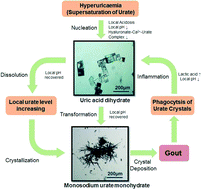The culprit of gout: triggering factors and formation of monosodium urate monohydrate†
Abstract
Gout is a crystal-induced inflammatory arthritis brought about by the deposition of monosodium urate monohydrate (MSUM). Hyperuricemia is considered an essential factor for gout formation. However, the in vivo MSUM crystallization mechanism is still uncertain, and only some of the patients with hyperuricemia are able to develop gout. Attempts were made to answer those unsolved questions based on the experimental methods developed by Perrin and Swift including (1) morphological studies of MSUM under various Na+ ion levels, (2) effect of pH and conversion from uric acid dihydrate (UAD) to MSUM, and (3) the synergistic effect of Na+, K+, and Ca2+ ions and hyaluronate chains on MSUM crystallization. Various MSUM morphologies such as “beachballs”, “urchin-like aggregates” and “bow-like aggregates” could be prepared at different Na+ ion concentrations at 37 °C. Consequently, the pathogenesis of gout might be related to the MSUM morphological transformation from a “beachball” structure to a needle. The conversion of UAD to MSUM was studied by adjusting the pH value. The determined UAD-to-MSUM pathway was thought to be followed by the MSUM deposition during phagocytosis when lactic acid was present. In addition, a new type of MSUM “fishtail” morphology was observed in the hyaluronate-, Na+ ion-, and Ca2+ ion-containing solutions. The synergistic effect of hyaluronate and the cations on the inhibition of MSUM crystallization was further verified based on the crystal yields. The higher water solubility of the hyaluronate–Ca-urate complex compared to the one of the urate ion might explain why only a fraction of hyperuricemic patients developed gout. Although there was no reported evidence about the complex, it was probable for it to minimize the risk of gout formation in hyperuricemic patients. Finally, the puzzle of gout formation was pieced together and illustrated.


 Please wait while we load your content...
Please wait while we load your content...